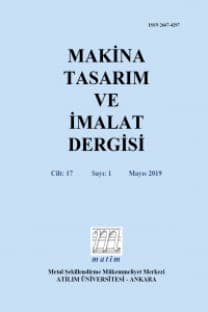Dördüncü Dereceden Polinom Türü Bir Akma Fonksiyonu Kullanarak AISI 304 Paslanmaz Çelik Sacın Anizotropik Davranışının Modellenmesi
Polinom türü akma fonksiyonu, Sonlu eleman simulasyonu, Dikdörtgen kap derin çekme, AISI-304 Çelik Sac
___
- 1. Hill, R., “A Theory of the Yielding and Plastic Flow of Anisotropic Metals”, Proc. Soc. London A, 1948, vol. 193, pp. 281-97.
- 2. Hill, R.; The Mathematical Theory of Plasticity, Oxford University Press Inc., New York, 1950.
- 3. Gotoh, M., “A Theory of Plastic Anisotropy Based on a Yield Function of Fourth Order (Plane Stress State)-I”. Int. J. Mech. Sci., 1977, vol.19, pp. 505-12.
- 4. Gotoh, M., “A Theory of Plastic Anisotropy Based on a Yield Function of Fourth Order (Plane Stress State)-II”. Int. J. Mech. Sci., 1977, vol.19, pp. 513-20.
- 5. Tong, W., “On the Certification of Positive and Convex Gotoh’s Fourth-Order Yield Function”. Numisheet 2018 Conference Series, 2018, vol. 1063, pp. 1-6.
- 6. Tong, W., “Generalized Fourth-Order Hill’s 1979 Yield Function for Modeling Sheet Metals in Plane Stress”. Acta Mech., 2016, vol. 227, pp. 2719-33.
- 7. Hill, R., “Theoretical Plasticity of Textured Aggregates”, Math. Proc. Camb. Philos. Soc., 1979, vol. 85, pp. 179-91.
- 8. Cazacu, O., Barlat, F., “Generalization of Drucker’s Yield Criterion in Orthotropy”, Math. Mech. Solids, 2001, vol. 6, pp. 613-630.
- 9. Hu, W., “Characterized Behaviors and Corresponding Yield Criterion of Anisotropic Sheet Metals”, Mat. Sci. Eng. A, 2003, vol. 345, pp. 139-44.
- 10. Hu, W., “An Orthotropic Yield Criterion in a 3-D General Stress State”, Int. J. Plast., 2005, vol. 21, pp. 1771-96.
- 11. Soare, S., C., Yoon, J.,W., Cazacu, O., “On the Use of Homogeneous Polynomials to Develop Anisotropic Yield Functions with Applications to Sheet Forming”, Int. J. Plast., 2008, vol. 24, pp. 915-44.
- 12. Suan, W., Yuan, Y.,X; Optimization Theory and Methods Nonlinear Programming, Springer Science Business Media, New York, 2006.
- 13. Hallquist, J., O.; Ls-Dyna Theory Manual. Livermore Software Technology Corporation, California, 2006.
- 14. Simo, J.C., Hughes, T.,J.,R.; Computational Inelasticity, Springer Verlag, New York, 1998.
- 15. Chaboche, J., L., Cailletaud, G., “Integration Methods for Complex Plastic Constitutive Equations”, Comput. Method. Appl. Mech. Eng., 1996, vol. 133, pp. 125-55.
- 16. Firat, M., Kaftanoglu, B., Eser, O., “Sheet Metal Forming Analyses with an Emphasis on the Springback Deformation”, J. Mater. Process. Tech., 2008, vol. 196, pp. 135-48.
- 17. Firat, M., “Computer Aided Analysis and Design of Sheet Metal Forming Processes: Part III: Stamping Die-Face Design”, Mater. Design, 2007, vol. 28(4), pp. 1311-20.
- 18. Yadav, A.D.: Process Analysis and Design in Stamping and Sheet Hydroforming, Doctoral Thesis, Ohio State University, 2008.
- ISSN: 1302-9487
- Başlangıç: 1986
- Yayıncı: Makina Tasarım ve İmalat Derneği
Bora ŞENER, Elif Sıla SELEK KILIÇARSLAN, Mehmet FIRAT
Umut Karagüzel, Ali Taner KUZU, Mustafa Bakkal
Genelleştirilmiş Plastik Deformasyon İş Kriterinin Hasar Tahmin Kabiliyeti
Toros Arda AKSEN, Bora ŞENER, Mehmet FIRAT
Kişiselleştirilmiş Robot Tasarımı için Kavramsal Tasarım Metodolojisi
Cevat ÇİÇEK, Cemil Günhan ERHUY, Hasan KINAGU, Niyazi EFE, Onur SARAY
